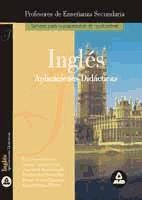
INGLES. PROFESORES DE ENSEÑANZA SECUNDARIA. APLICACIONES DIDACTICAS
- Ed. MAD
- Juan Doncel Córdoba
- (09/2005)
- 344 páginas;
- ISBN-13: 9788466510660
La prueba oral del actual sistema de oposiciones consta de dos partes: en la primera se deben exponer los aspectos científicos del tema seleccionado o los contenidos del mismo y en la segunda se debe relacionar el contenido del tema con el currículo de la Educación Secundaria o del Bachillerato, extrayendo aspectos didácticos del mismo aplicables a cualquier nivel del alumnado de estas etapas educativas. En consecuencia, al finalizar la exposición teórica del tema se debe exponer una aplicación didáctica de algún contenido del tema a un grupo de alumnos seleccionado libremente por el opositor.
Las directrices dadas para el desarrollo curricular de las materias de Educación Secundaria Obligatoria nos ponen de manifiesto que las programaciones de aula se deben realizar mediante la planificación de unidades didácticas) entendiendo por Unidad didáctica: "toda unidad de trabajo, de duración variable, que organiza un conjunto de actividades de enseñanza y aprendizaje y que responde, en su máximo nivel de concreción, a todos los elementos del currículo: qué, cómo y cuándo enseñar y cómo evaluar".
Esta es la razón por la que para responder a las exigencias de la prueba oral hemos decidi elaborar una serie de modelos de unidades didácticas, procesos completos de enseñanza y aprendizaje, aplicables a todos los temas del Temario A. La selección de los modelos de unidades didácticas la hemos realizado en función de los bloques de contenido en los que se puede estructurar el Temario A; en función de su aplicación a las diferentes etapas; Educación Secundaria y Bachillerato y siguiendo el currículo de Lengua inglesa en estas etapas. Los modelos propuestos sólo pretenden ser una guía de estudio u orientación, modificable y ampliable, en función de la experiencia didáctica del opositor.
PRIMERA PARTE. Fundamentación didáctica
SEGUNDA PARTE. Modelos de unidades didácticas del área de Lengua inglesa
Modelos aplicables a los temas 1 a 6. Procesos metodológicos y de competencia
comunicativa.
Unit 1. Evolution of Language Didactics. Current Tendencies. The Communicative
Approaches
Unit 2. General theories about foreign language learning and acquisition.
Interlanguage and error treatment
Unit 3. The Process of Communication. Functions of Language. Language in use.
Negotiation of Meaning
Unit 4. Communicative competence
Unit 5. Oral communication
Unit 6. Written communication
Modelos aplicables a los temas 7 a 28. Fonología y lengua.
Unit 7. Phonological system of English (I): vowels. Phonetic symbols. Strong and weak
forms. Diphthongs. Comparison with the Spanish phonological system
Unit 8. Phonological system of English (II): consonants. Phonetic symbols. Comparison
with the Spanish phonological system
Unit 9. Phonological system of English (III): stress, rhythm and intonation. Comparison
with the Spanish phonological system
Unit 10. Vocabulary. Characteristics of the formation of words in English. Prefixes,
sufixes and composition.
Unit 11. The word as a linguistic sign, homonymy, synonymy, antonymy and false
friends.
Unit 12. Gramatical concepts: reflection on language and language learning.
Unit 13. Expression of quantity.
Unit 14. Expression of quality. Expression of degree and comparison.
Unit 15. The expression of manner, means and instrument. Process adjuncts.
Unit 16. Expression of the possession. Possessive pronouns.
Unit 17. Adjunts of space.
Unit 18. Temporal localisation, temporal relations, frequency.
Unit 19. Time and tense. Aspect and mood.
Unit 20. Auxiliar and modal verbs. Form and functions.
Unit 21. The infinitive and the-ing form.
Unit 22. Multi-word verbs.
Unit 23. Sentence structure: statements, questions, negation and exclamations.
Unit 24. Assertion, non-assertion and emphasis.
Unit 25. Causal, consequence and purpose relations.
Unit 26. The expression of condition, hypothesis, contrast and doubt.
Unit 27. Passive voice. Forms and functions.
Unit 28. Linguistic Macrofunctions used to express the most common communicative
intentions.
Modelos aplicables a los temas 29 a 40. Discurso y tipos de texto.
Unit 29. Discourse Analysis and Discourse Articulation.
Unit 30. Direct and indirect speech.
Unit 31. Text and context. Types of text. Register.
Unit 32. The narrative text.
Unit 33. Descriptive texts.
Unit 34. Argumentative texts.
Unit 35. The explanatory text. Structure and characteristics.
Unit 36. The dialogical texts. Structure and characteristics.
Unit 37. Literary Language. Literary Genres. Literary Criticism.
Unit 38. The scientific, technological, commercial and business English language.
Unit 39. Strategies for text analysis.
Unit 40. Strategies of communication.
Modelos aplicables a los temas 41 y 42. Influencia de otras lenguas.
Unit 41. The Romanization. Influence of Latin on the English language. Loans and
borrowings
Unit 42. The norman conquest. Influence of French on the English language. Loan
words and calques
Modelos aplicables a los temas 43 a 61. Aspectos literarios.
Unit 43. Oral medieval literature. Geoffrey Chaucer: the Canterbury tales
Unit 44. Shakespeare and his time
Unit 45. Great Britain in the 18th century. Socio-economic development and
political evolution. Cultural and technical activity. Great novelists
Unit 46. Historical configuration of the United States of America: from Independence
to the Secession War. Reference Novels: The Scarlet Letter. The Red Badge
of Courage
Unit 47. The English industrial revolution; its influence as a model of historical
transformation. Social and political changes through the literature of the epoch:
Charles Dickens
Unit 48. Romanticism in Great Britain: poetry and novel
Unit 49. The British Empire
Unit 50. The Victorian novel
Unit 51. Oscar Wilde and Bernard Shaw
Unit 52. The historical evolution of the United States: from A. Lincoln to F.D.
Roosevelt
Unit 53. The novel, the tales and poetry in the USA: H. Melville, Edgar Allan Poe
and Walt Whitman
Unit 54. The humour of Mark Twain and Henry James’ cosmopolitanism
Unit 55. The lost generation
Unit 56. The historic relations between Ireland and Great Britain. Irish authors:
S. O’Casey and J. Joyce
Unit 57. The United Kingdom during the inter-war period and in The Second World
War. Representative literary authors
Unit 58. Political, social and economic development in the United Kingdom and Ireland
since 1945. Their part in the European Community. The Literary scene in those
countries during this period
Unit 59. Political, social and economic evolution of the U.S. since 1945
Unit 60. Detective novels
Unit 61. The effects of cinema on the expansion of literature in the English language
Modelos aplicables a los temas 62 a 65. Aspectos políticos y educativos.
Unit 62. The Commonwealth. Cultural diversity. The development of Linguistic
variations. Intercultural influences and representations. The latest from E.M.
Forster, Doris Lessing and N. Gordimer
Unit 63. British institutions. Parliamentary chambers. Government. Political parties
and elections. The crown
Unit 64. The U.S. institutions. Regions. The president. The Congress. Political parties
and elections
Unit 65. The anglo-saxon educational system
Modelos aplicables a los temas 66 a 69. Medios de comunicación y cultura.
Unit 66. Cultural dimension of the English language in the world
Unit 67. Mass media in English (1): the journalistic style. Broadsheets and tabloids
Unit 68. Mass media in English (2): radio and television. Advertising in
English-speaking countries: linguistic and semiotic aspects
Unit 69. English culture and society
¡Suscríbete a nuestra newsletter!
- Subescala de Secretaría-Intervención del Ministerio para la Transformación Digital y de la Función Pública
- Subescala de Intervención-Tesorería, categoría de entrada del Ministerio de Política Territorial y Función Pública
- Facultativo Especialista de Área del Servicio de Salud de las Islas Baleares (IB-SALUT)
- Subescala de Secretaría, categoría de entrada del Ministerio de Política Territorial y Función Pública
- Médicos de familia (EAP) del Servicio de Salud de las Islas Baleares (IB-SALUT)
Últimas noticias
- Instituto Catalán de la Salud. Aprobada OEP 2019 con 1.207 plazas diversas categorías
- Servicio Murciano de Salud (SMS). Aprobada OEP 2019 con 543 plazas diversas categorías
- Canarias. Aprobada OEP 2019 con 908 plazas de diversas categorías de la Administración General y Servicio Canario de Salud (SCS)
- Galicia. Aprobada OEP 2019 con 2.316 plazas personal docente
- Servicio Andaluz de Salud (SAS). Aprobada OEP 2019 con 3.536 plazas Más noticias
Copyright © Agapea Factory S.A 2025

